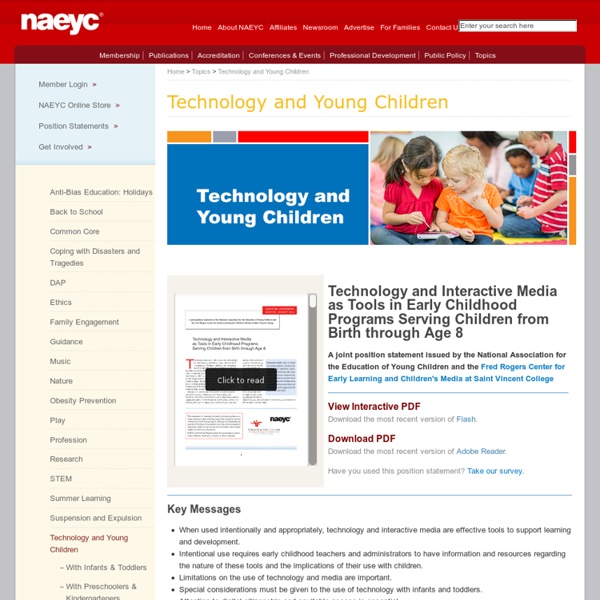Web Literacy: Where the Common Core Meets Common Sense
Are you as worried as we are that the overall impact of technology on our children’s ability to solve complex research problems is negative? Have you heard a child near you say, “Just Google it,” when asked to describe the meaning of life? Research shows that students primarily use one search engine and then only look at the first page of results.
The Fred Rogers Center
Do technology tools and interactive media like iPads, cameras, or e-readers, belong in the early childhood classroom? If so, how should early childhood educators be using them? What are the best ways and when are the best times to use technology with very young kids in a classroom setting?
Teach your students the right way to Google
Kelly Maher November 24th, 2014 In the age of the split-second Google search, it’s more critical than ever to train students to distinguish between primary and secondary sources As in decades past, proper research methods are an essential skill for today’s students. At a time when most students (and adults, for that matter) are accustomed to heading straight to Google to answer all of their questions, being able to sagely sift through the good, the bad, and the ugly of search results is key to creating independent 21st century thinkers. However, even when used properly, Google is not always the right resource.
Selected Resources on Technology in Early Childhood Education
Essential Resources Recent reports Barron, B., G.
Ways to Evaluate Educational Apps
I am conducting a series of workshops in Florida and was asked to share a rubric to help teachers evaluate educational apps as part of the workshop. In 2010 Harry Walker developed a rubric, and I used his rubric (with some modifications by Kathy Schrock) as the basis for mine. (Read Harry Walker's paper Evaluating the Effectiveness of Apps for Mobile Devices.) I kept in mind that some apps are used to practice a discrete skill or present information just one time. Others are creative apps that a learner may use again and again, so it's a challenge to craft a rubric that can be used for a wide span of purposes. I tried to make my rubric work for the broadest range of apps, from drill and practice to creative endeavors, while stressing the purpose for using the app.
Essential Conditions
Shared Vision Proactive leadership develops a shared vision for educational technology among all education stakeholders, including teachers and support staff, school and district administrators, teacher educators, students, parents and the community. Empowered Leaders
SETDA - Case Studies 2012
Under current and prior incarnations of the the Elementary and Secondary Education Act of 1965 (ESEA), Congress granted the U.S. Department of Education specific responsibility to support states and school districts to improve student academic achievement through the use of technology. In 2010, the Obama Administration released its blueprint for the reauthorization of ESEA and in parallel ceased requesting federal budget support for educational technology programs in continuous operation since 1994.
NETS Implementation - home
TICAL - Technology Information Center for Administrative Leadership



